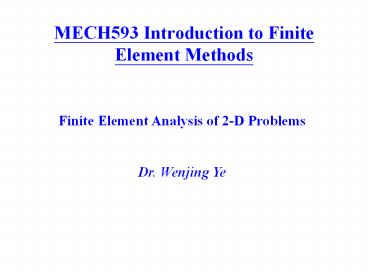MECH593 Introduction to Finite Element Methods - PowerPoint PPT Presentation
1 / 17
Title: MECH593 Introduction to Finite Element Methods
1
MECH593 Introduction to Finite Element Methods
Finite Element Analysis of 2-D Problems Dr.
Wenjing Ye
2
2-D Discretization
Common 2-D elements
3
2-D Model Problem with Scalar Function- Heat
Conduction
- Governing Equation
in W
- Boundary Conditions
Dirichlet BC
Natural BC
Mixed BC
4
Weak Formulation of 2-D Model Problem
- Weighted - Integral of 2-D Problem -----
- Weak Form from Integration-by-Parts -----
5
Weak Formulation of 2-D Model Problem
- Green-Gauss Theorem -----
where nx and ny are the components of a unit
vector, which is normal to the boundary G.
6
Weak Formulation of 2-D Model Problem
- Weak Form of 2-D Model Problem -----
EBC Specify T(x,y) on G NBC Specify
on G
where
is the normal outward flux on
the boundary G at the segment ds.
7
FEM Implementation of 2-D Heat Conduction Shape
Functions
Step 1 Discretization linear triangular element
T1
Derivation of linear triangular shape functions
T2
Let
T3
Interpolation properties
Same
8
FEM Implementation of 2-D Heat Conduction Shape
Functions
linear triangular element area coordinates
T1
A2
A3
A1
T2
T3
9
Interpolation Function - Requirements
- Interpolation condition
- Take a unit value at node i, and is zero at all
other nodes - Local support condition
- fi is zero at an edge that doesnt contain node
i. - Interelement compatibility condition
- Satisfies continuity condition between adjacent
elements over any element boundary that includes
node i - Completeness condition
- The interpolation is able to represent exactly
any displacement field which is polynomial in x
and y with the order of the interpolation
function
10
Formulation of 2-D 4-Node Rectangular Element
Bi-linear Element
Let
Note The local node numbers should be arranged
in a counter-clockwise sense. Otherwise, the area
Of the element would be negative and the
stiffness matrix can not be formed.
f2
f4
f1
f3
11
FEM Implementation of 2-D Heat Conduction
Element Equation
- Weak Form of 2-D Model Problem -----
Assume approximation and let w(x,y)fi(x,y) as
before, then
where
12
FEM Implementation of 2-D Heat Conduction
Element Equation
13
Assembly of Stiffness Matrices
14
Imposing Boundary Conditions
The meaning of qi
3
3
1
1
1
2
2
3
3
1
1
1
2
2
15
Imposing Boundary Conditions
Consider
Equilibrium of flux
FEM implementation
16
Calculating the q Vector
Example
17
2-D Steady-State Heat Conduction - Example
A
D
AB
CD convection
DA and BC
0.6 m
C
B
0.4 m
y
x

